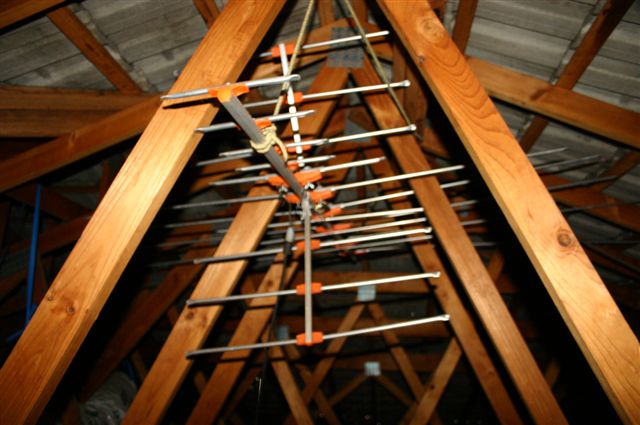
When we moved into the new home, I couldn’t find the TV antenna. But when we plugged in the TV, we got acceptable reception and then lazyiness kicked in. But the digital reception doesn’t cut it, so I decided to find out if our TV reception was coming from a coat hanger or something more sophisticated. Turns out you can hang an antenna in your roofspace using a length of rope and have a passable signal. Excpet for SBS. Pretty roofline, poor reception. A pretty roofline would be more important if it didn’t already have a evaporative cooling stack and a skylight breaking it up.
It’s winter here, and the roofspace was roasting hot. So, while the insulation had been abused and moved, there was enough of it doing it’s work that… gaugrh. Hot.
I also found out that our ventilation fans vent straight into the roofspace (great for both heat loss and moisture damage) and that our kitchen extractor fan doesn’t vent anywhere, even though it has a riser in the kitchen. Another housing disaster I’m going to have to address.
Now I need to buy a post to externally mount this bastard of an antenna onto. And a length of coax… or perhaps I’ll recycle one of the many lengths running around up there. There used to be a satelite TV link running off to the garage, I think that one might be long enough (turns out no: satelite hook-up was disconnected with wire cutters, leaving insufficient wire to make the distance). Currently the coax runs into a four-way splitter (three splits used), and I have my concerns that the splitter is contributing to our reception issues. Any opinions?

There’s some (not much) information here.
Have you considered getting an amplifier? I don’t know much about them, but have a friend who says it improved his reception significantly.
How’s the channel 31?
Once you’ve got it all fixed, will the signal good enough for the inevitable later dip into Digital TV?
Don’t forget to have ABC working on Saturday for all the exterminating at 7:30 🙂
Don’t trust a signal amplifier to do what a low-gain antenna can’t; it will boost the signal as well as the noise, and most of the time the noise will become more obvious and make image worse.
Every interruption in the cable will add some signal loss, so use a single piece of 75-ohm coaxial cable to connect the antenna to the main splitter. Get a brand-name (if possible), low-loss (-2dB to -6dB) splitter, with upper band cut over 1000 MHz for easier upgrade to cable TV in the future. There are splitters with a pass-through port (no attenuation), in case you will want to daisy-chain splitters with as little signal loss as possible. Most good splitters will also block TV sets from influencing one another through the splitter.
Checking cables and splitters without messing with the antenna is the easiest thing to do. Get a portable TV in the attic, connect it to the antenna, see how good or poor the signal is straight from the source. If you then decide to get this antenna on a pole, make sure you can hold that pole in place very tightly; the wind and the birds are more powerful that one would imagine. The antenna should be high enough to rise above the rooftops in its “path”, and about 1-2 meters above your roof’s highest point. Don’t place your antenna close to the lightning bolt, if you have one, nor higher than it; your antenna will have higher chances of being hit by lightning, together with all TVs in the house even if switched off. The highest point in your vicinity will most likely be hit, be it a lightning rod on a tall building or a hill nearby.
Hope this helps. 🙂
Splitters are nasty things; a four way splitter means you only get a quarter of the
signal from each outlet. That is true even if only one or two TVs are connected. You
should also connect a 75 ohm resistor across unused sockets.
Also important is the orientation of the antenna to face Mt Dandenong. Though some inner city
areas get service from UHF translators around Richmond.
Big metal objects inside the roof can reduce signals or cause reflections as well.
Coax is important, so use a single length of new stuff – don’t join up scraps. RG-6 is OK.
Peter
PS: A preamp (or distribution amp) may help but don’t do this until you’ve exhausted all other options with the coax and antenna. Also in the meantime remove the splitter and have the antenna feeding one set only to see if reception is better as a test.